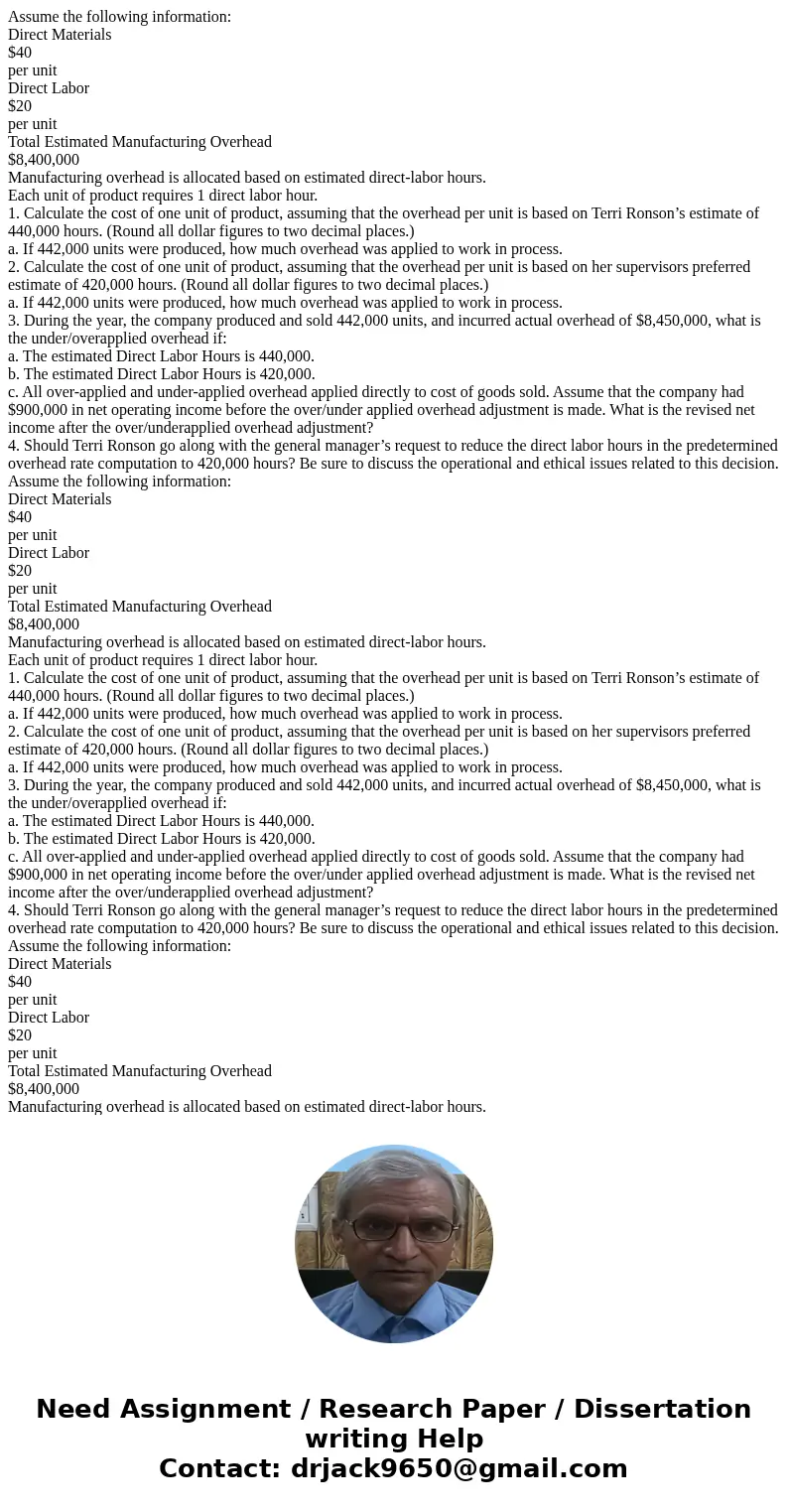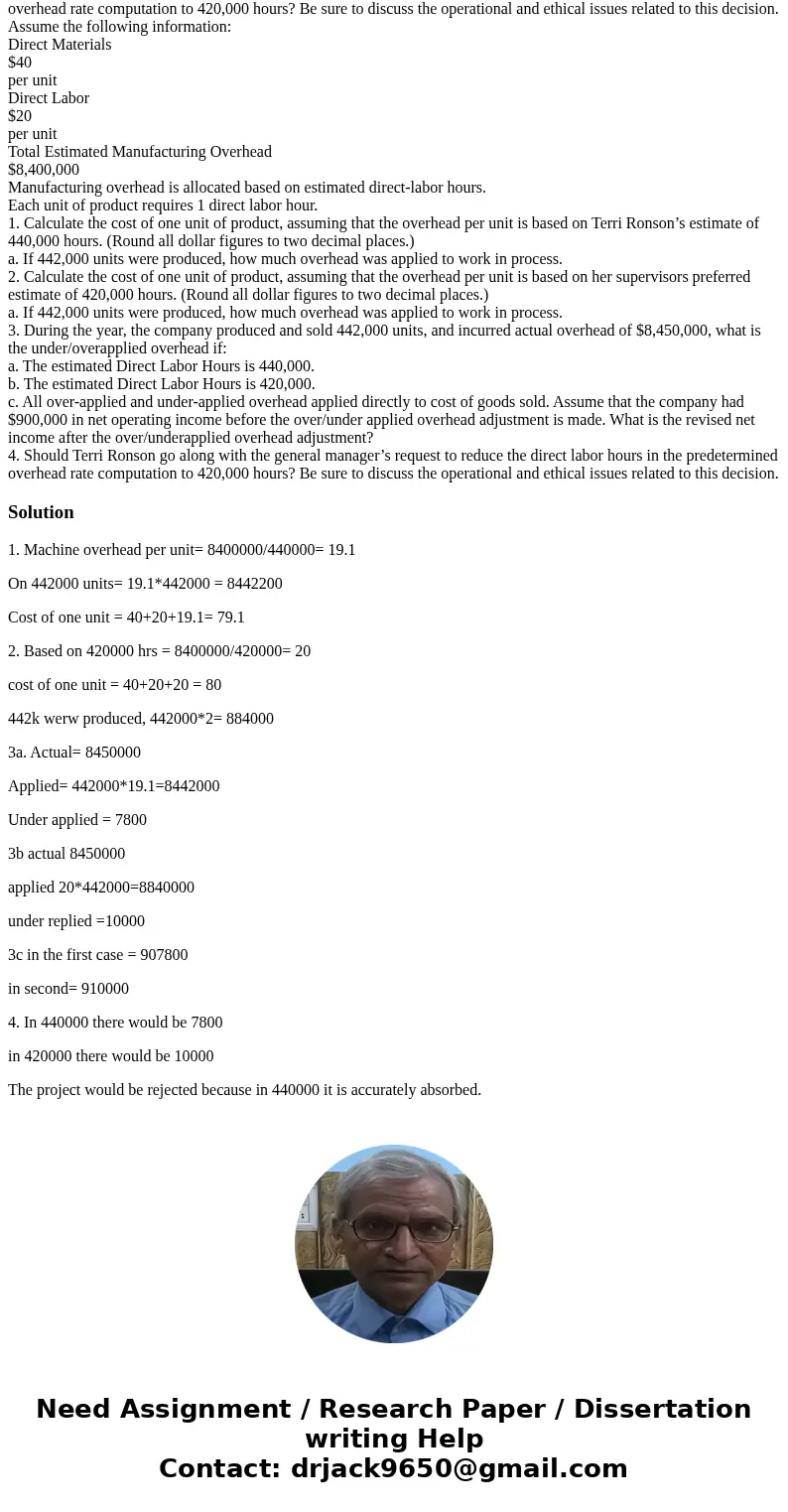Assume the following information Direct Materials 40 per uni
Assume the following information:
Direct Materials
$40
per unit
Direct Labor
$20
per unit
Total Estimated Manufacturing Overhead
$8,400,000
Manufacturing overhead is allocated based on estimated direct-labor hours.
Each unit of product requires 1 direct labor hour.
1. Calculate the cost of one unit of product, assuming that the overhead per unit is based on Terri Ronson’s estimate of 440,000 hours. (Round all dollar figures to two decimal places.)
a. If 442,000 units were produced, how much overhead was applied to work in process.
2. Calculate the cost of one unit of product, assuming that the overhead per unit is based on her supervisors preferred estimate of 420,000 hours. (Round all dollar figures to two decimal places.)
a. If 442,000 units were produced, how much overhead was applied to work in process.
3. During the year, the company produced and sold 442,000 units, and incurred actual overhead of $8,450,000, what is the under/overapplied overhead if:
a. The estimated Direct Labor Hours is 440,000.
b. The estimated Direct Labor Hours is 420,000.
c. All over-applied and under-applied overhead applied directly to cost of goods sold. Assume that the company had $900,000 in net operating income before the over/under applied overhead adjustment is made. What is the revised net income after the over/underapplied overhead adjustment?
4. Should Terri Ronson go along with the general manager’s request to reduce the direct labor hours in the predetermined overhead rate computation to 420,000 hours? Be sure to discuss the operational and ethical issues related to this decision.
Assume the following information:
Direct Materials
$40
per unit
Direct Labor
$20
per unit
Total Estimated Manufacturing Overhead
$8,400,000
Manufacturing overhead is allocated based on estimated direct-labor hours.
Each unit of product requires 1 direct labor hour.
1. Calculate the cost of one unit of product, assuming that the overhead per unit is based on Terri Ronson’s estimate of 440,000 hours. (Round all dollar figures to two decimal places.)
a. If 442,000 units were produced, how much overhead was applied to work in process.
2. Calculate the cost of one unit of product, assuming that the overhead per unit is based on her supervisors preferred estimate of 420,000 hours. (Round all dollar figures to two decimal places.)
a. If 442,000 units were produced, how much overhead was applied to work in process.
3. During the year, the company produced and sold 442,000 units, and incurred actual overhead of $8,450,000, what is the under/overapplied overhead if:
a. The estimated Direct Labor Hours is 440,000.
b. The estimated Direct Labor Hours is 420,000.
c. All over-applied and under-applied overhead applied directly to cost of goods sold. Assume that the company had $900,000 in net operating income before the over/under applied overhead adjustment is made. What is the revised net income after the over/underapplied overhead adjustment?
4. Should Terri Ronson go along with the general manager’s request to reduce the direct labor hours in the predetermined overhead rate computation to 420,000 hours? Be sure to discuss the operational and ethical issues related to this decision.
Assume the following information:
Direct Materials
$40
per unit
Direct Labor
$20
per unit
Total Estimated Manufacturing Overhead
$8,400,000
Manufacturing overhead is allocated based on estimated direct-labor hours.
Each unit of product requires 1 direct labor hour.
1. Calculate the cost of one unit of product, assuming that the overhead per unit is based on Terri Ronson’s estimate of 440,000 hours. (Round all dollar figures to two decimal places.)
a. If 442,000 units were produced, how much overhead was applied to work in process.
2. Calculate the cost of one unit of product, assuming that the overhead per unit is based on her supervisors preferred estimate of 420,000 hours. (Round all dollar figures to two decimal places.)
a. If 442,000 units were produced, how much overhead was applied to work in process.
3. During the year, the company produced and sold 442,000 units, and incurred actual overhead of $8,450,000, what is the under/overapplied overhead if:
a. The estimated Direct Labor Hours is 440,000.
b. The estimated Direct Labor Hours is 420,000.
c. All over-applied and under-applied overhead applied directly to cost of goods sold. Assume that the company had $900,000 in net operating income before the over/under applied overhead adjustment is made. What is the revised net income after the over/underapplied overhead adjustment?
4. Should Terri Ronson go along with the general manager’s request to reduce the direct labor hours in the predetermined overhead rate computation to 420,000 hours? Be sure to discuss the operational and ethical issues related to this decision.
Solution
1. Machine overhead per unit= 8400000/440000= 19.1
On 442000 units= 19.1*442000 = 8442200
Cost of one unit = 40+20+19.1= 79.1
2. Based on 420000 hrs = 8400000/420000= 20
cost of one unit = 40+20+20 = 80
442k werw produced, 442000*2= 884000
3a. Actual= 8450000
Applied= 442000*19.1=8442000
Under applied = 7800
3b actual 8450000
applied 20*442000=8840000
under replied =10000
3c in the first case = 907800
in second= 910000
4. In 440000 there would be 7800
in 420000 there would be 10000
The project would be rejected because in 440000 it is accurately absorbed.


 Homework Sourse
Homework Sourse